![]() 1:1 Giants of the Sea:
There is also a giant squid among the illustrious exhibits in the
Stralsund Ozeaneum.
1:1 Giants of the Sea:
There is also a giant squid among the illustrious exhibits in the
Stralsund Ozeaneum.
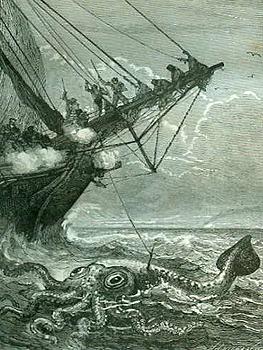 The Alecton crew tries to catch a giant squid. From "20000 leagues under the seas" by Jules Verne. Reference: Andreas Fehrmann. |
Up to the middle of the 19th century, the giant squid was a sea monster from ancient legends, about which science only knew what tales sailors and fishermen told. Olaus Magnus in the 16th century, Egede and Pontoppidan in the 18th century, had described the kraken. The mostly exaggerated tales from the middle ages more look like a cock-and-bull story than scientific reports.
Whale hunters reported, that sperm whales in their death throes often disgorged something that resembled a squid's arms, only it was much larger. When the whale was cut open, often they found horn beaks the size of their hands, resembling a parrot's beak. The whalers concluded, that sperm whales fought with giant squids in the deep. Herman Melville concurs, 1851 in "Moby Dick" he describes the encounter of his whale ship Pequod with a giant squid.
It was not until three years after the Pequod's literary encounter with the giant squid, that the subject was first dealt with scientifically.
The Danish scientist Japetus Steenstrup received the beak, the shell and some suckers of a giant squid, that had been washed ashore a year previously on the Danish coast. He compared the material with corresponding organs of smaller squid species and concluded that it had to have belonged to a giant squid species, which he named Architeuthis, the first and largest of the squids. The genus Architeuthis Steenstrup 1856 until today means the giant squids from the Atlantic.
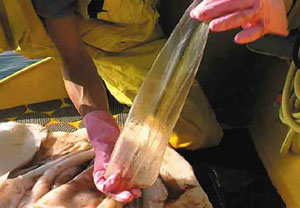 A giant squid's shell. Because of their sword-like form, those are also called a gladius. Reference: Aldebaran Expedition. |
A large part of the scientific research on giant squids at that time is closely connected with Newfoundland Island in the Northwest of America.
![]() A map of
Neufoundland.
A map of
Neufoundland.
Twenty years after Steenstrup had described the giant squid Architeuthis, in 1873 a giant squid attacked a small fisher boat near Portugal Cove, but withdrew, after the fishermen had hacked off two of its arms. Those arms, parts of the larger tentacles, were taken ashore and so got into the hands of Reverend Harvey in nearby St. John's. Harvey examined the arm parts, described the fishermen's fight in several newspaper articles and then sent the arm parts to the biologist Verrill in New Haven, Connecticut. Two months later the fishermen in the Logy Bay, also Newfoundland, managed, so to speak to catch the Big One.
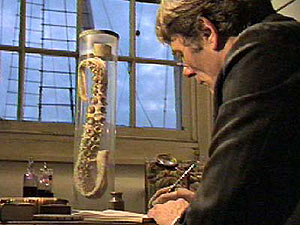 Reverend Harvey in a BBC movie. |
They managed to catch a giant squid nine metres (27 feet) long and to take it ashore. Reverend Harvey bought the giant squid and had it photographed in his living room. Afterwards he sent it to Professor Verril who conformed what had been assumed for some time so far: Architheuthis exists and it is really a giant squid.
Since then giant several hundred specimens of giant squids have been caught and washed ashore in different species (three distinct species are assured, there are numerous more insecure species) all over the world. The last specimen was washed ashore on the 22nd of June 2002 in Tasmania on the South coast of Australia.
Of the giant squid's biology, only the morphology has so far been researched. Until today nobody has managed to observe giant squids in their natural environment. Giant squids have been caught with dragnets from the ocean floor, as well as with floating nets in the open sea. So today it is assumed that giant squids live in depths of 300 to 1000 metres (1000 to 3000 feet) on the continental shelf' slope. As beaks of juvenile giants squids have been found in the stomachs of albatrosses and certain fish, it is also assumed that giant squids dive into ever deeper water during their live.
Giant squids are cephalopods (Cephalopoda). They have ten arms altogether, of which two long tentacles with club-like broadened ends armed with suckers to catch the prey.
Eight short arm around the mouth then guide the prey to the mouth. There a horn beak cuts the prey in small pieces, that are then further ground by the radula. While freshly caught squids and those washed ashore usually appear white, their natural colour is supposed to be red. Those squids appear to be white, because the outer layers of the skin have been grazed off by the surf.
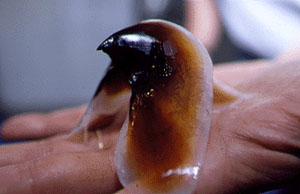 A giant squid's beak. Reference: American Museum of Natural History. |
|
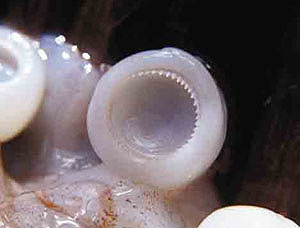 Enlarged picture of a giant squid's suckers. Reference: Aldebaran Expedition. |
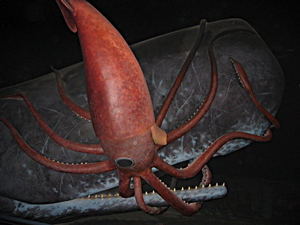 A giant squid fighting against a sperm whale. Diorama in the Natural History Museum in New York. Picture: Mike Goren, Wikipedia. |
Giant squids are often said to effuse a disgusting smell of ammonia. That is because giant squids are among those squid species that keep ammonia in the muscular tissue to enhance buoyancy. It is assumed that giant squids can float in the water that way, without having to invest muscle power. So for humans giant squids are indigestible. The contrary is fact, however, with sperm whales (Physeter macrocephalus). A large part if a sperm whale's diet consists of squids, among those also giant ones. As described before, in the stomachs of sperm whales, collections of squid beaks can be found. Sperm whales' skin often carry the scars of giant squids' suckers armed with teeth. The idea to calculate the squid's size from those scars is made more difficult by the fact that sperm whales, of course, grow and so the result is falsified.
In contrary to sperm whales, giant squids orient optically. As among smaller squid species, a giant squid's eyes are large in relation to its body. Those larges optical organs in the animal kingdom are as big as a soup plate.
There are also interesting things to be said about giant squids' methods of reproduction. Female giant squids have been caught with spermatophores (sperm packets, see also snails' reproduction) in their arm tissue, supposedly placed there by males. It remains unclear, how the female gets hold of the sperm cells to fertilise any eggs. It is assumed either the female opens the spermatophores on its own, or that the spermatophores are removed hormonally from the tissue. Even young females have been caught with very many implanted spermatophores, which leads to the conclusion, that giant squids are solitary and rarely meet other giant squids.
Very little is known about giant squids' behaviour. The assumption is that they are not highly active hunters like their smaller relatives, but carrion eaters and lurking hunters. In giant squids' stomachs, fish and other squids have been found. Because of he ammonia in giant squids' musculature, for a long time the assumption has been that giant squids are slow lurking animals. This may be doubted after the first movie pictures of a live giant squid, which instead point towards giant squids being highly aggressive hunters.
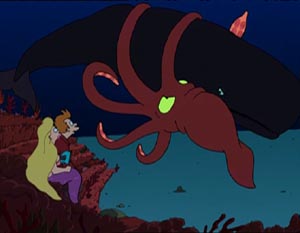 Futurama (2.12): The Deep South. |
Large sea animals, like sperm whales, are however not among their usual prey. So it may be called sure that sperm whales hunt the giant squid and not the other way round.
Much of giant squids' biology is either unknown, are must be concluded, together with the anatomical material present, from the behaviour of smaller, better known squid species.
For a long time, the experiment to supply sperm whales with cameras, to film giant squids, have been without success. 2004 Japanese scientists (Tsunemi Kubodera of the National Science Museum and Kyoichi Mori of the Ogasawara Whale Watching Association) managed to film a live giant squid with a network a cameras. Because the giant squid lost parts of an arm in the process, even DNA research was possible.
In the meantime there have been impressive observations of the multiple possibilities to use tentacles, as well as giant squids' bioluminescence, used for hunting as well as for communication.
Certainly, today we know much more about giant squids, as did Japetus Steenstrup. But we hardly can say to know everything about those creatures living in the deepest parts of the sea. And so even the giant squid, at least partly, will always remain a mystery, until the progress of technology allows man to finally completely reveal this secret of nature.
Additional Information: